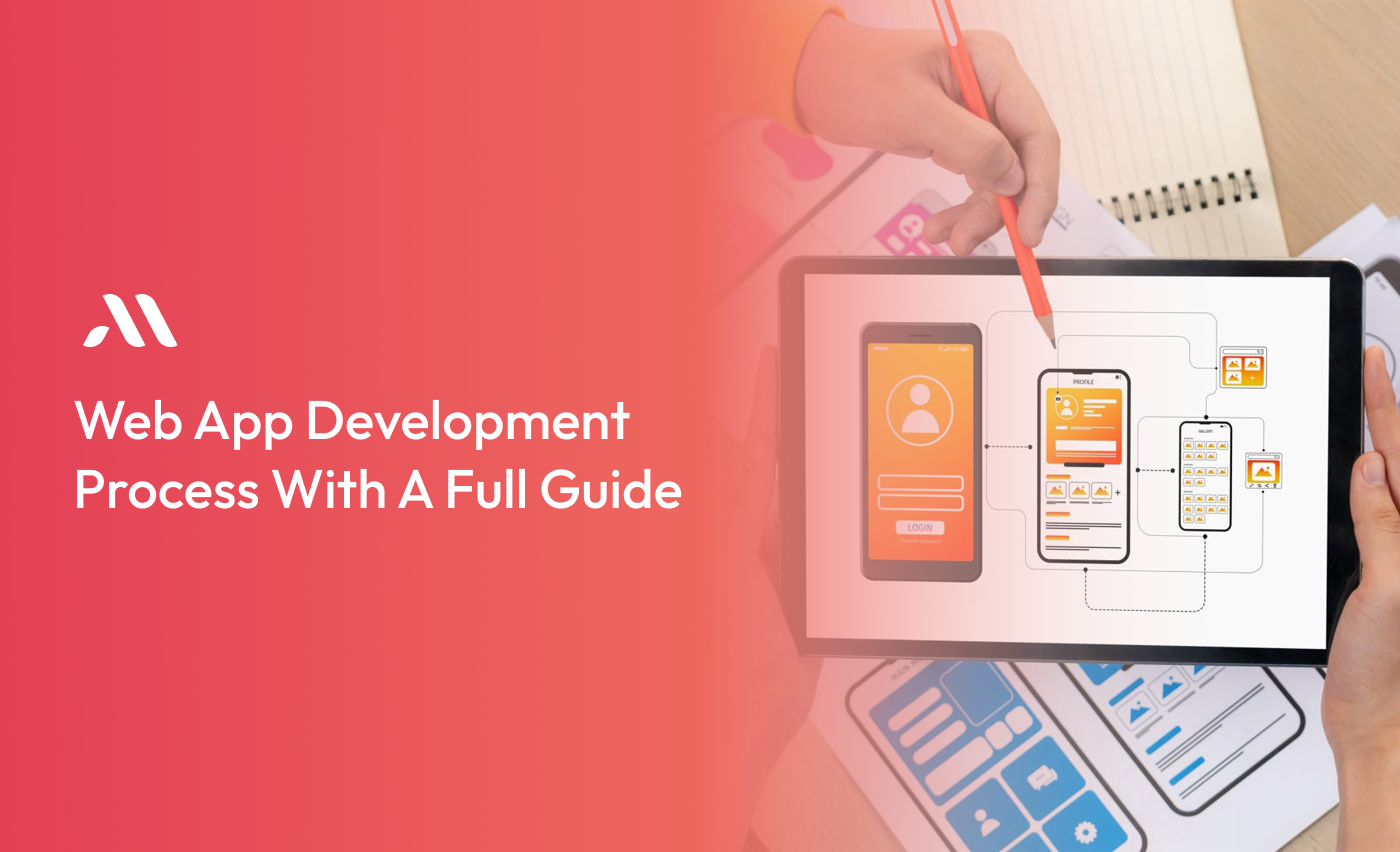Creating a web application can be an exciting journey, whether you're a beginner or an experienced developer. By following a step-by-step process, you can transform your idea into a fully functional web application. This blog will walk you through the essential steps involved in developing a web application, using simple language and important keywords to help you understand each phase.
What is a Web App?
A web application, or web app, is a software application that runs on a web server rather than being installed on a local device. Users access web app through a web browser with an active internet connection. Unlike traditional desktop applications, web apps can be used on various devices, including desktops, laptops, tablets, and smartphones, without needing to install any software on the user's device.
Web applications are built using web technologies such as HTML, CSS, and JavaScript for the front end, and various programming languages like Python, Java, PHP, or Node.js for the back end.
Examples of web applications include email clients like Gmail, social media platforms like Facebook, online banking services, e-commerce sites like Amazon, and productivity tools like Google Docs. These applications provide a seamless user experience, allowing users to perform a wide range of tasks directly from their web browsers.
What are Progressive Web Apps?
Progressive Web Apps (PWAs) are a type of web application that combines the best features of both web and mobile applications. They are designed to provide a seamless, app-like experience directly within a web browser.
PWAs leverage modern web technologies to deliver fast, reliable, and engaging user experiences, even in conditions with poor or intermittent internet connectivity.
Progressive Web Apps bridge the gap between traditional web applications and native mobile apps, offering a versatile and powerful solution for delivering high-quality user experiences across all devices and network conditions.
Why a Web App is Often Better Than a Mobile App
Web applications (web apps) and mobile applications (mobile apps) each have their own advantages, but there are several reasons why web apps can be the better choice in many situations. Here are the key benefits of web apps over mobile apps:
Cross-Platform Compatibility:
Web apps are accessible from any device with a web browser and an internet connection. This means they work across various platforms (Windows, macOS, Linux, Android, iOS) without the need for separate versions.
No Installation Required:
Users can access web apps directly through a URL without needing to download or install anything. This reduces friction for users who are hesitant to install new software and saves storage space on their devices.
Easier Maintenance and Updates:
Web apps are updated on the server side, so users always access the latest version without needing to download updates. This simplifies maintenance and ensures that all users have access to new features and bug fixes immediately.
Cost-Effective Development:
Developing a web app is often more cost-effective than building native mobile apps for multiple platforms. A single codebase can serve all users, reducing development time and costs.
Accessibility:
Web apps can be made accessible to a wider audience, including those using assistive technologies. Web standards provide guidelines for making web content accessible to people with disabilities.
SEO and Discoverability:
Web apps can be indexed by search engines, making them discoverable through search results. This can drive organic traffic to the app without requiring users to visit an app store.
Universal Access:
Web apps can be accessed from anywhere in the world, provided there is internet connectivity. This makes them ideal for reaching a global audience.
Instant Availability:
Users can start using web apps immediately after finding them online, without the delay of downloading and installing an app.
Lower Device Dependency:
Web apps are less dependent on the specific hardware or operating system of a device. This makes them more versatile and less affected by the fragmentation of mobile device ecosystems.
Easier Sharing:
Sharing a web app is as simple as sharing a URL. This makes it easy for users to recommend the app to others through email, social media, or messaging.
Consistent User Experience:
Web apps provide a consistent user experience across different devices, as they are accessed through a web browser that renders the app similarly on all platforms.
Types of Web Apps
Web apps come in various forms, each serving different purposes and offering unique features. Understanding the different types of web applications can help you choose the right approach for your project. Here are some common types of web apps:
Static Web Apps:
- Description: Static web apps display fixed content to users. The content does not change in response to user interactions and is usually pre-rendered HTML, CSS, and JavaScript.
- Use Cases: Personal portfolios, company landing pages, informational websites.
Dynamic Web Apps:
- Description: Dynamic web apps generate content on the fly based on user interactions, inputs, and other factors. They often use server-side scripting languages like PHP, Python, or Ruby to create dynamic content.
- Use Cases: Social media platforms, content management systems (CMS), e-commerce websites.
Single Page Apps (SPAs):
- Description: SPAs load a single HTML page and dynamically update content as the user interacts with the app. This approach provides a smooth, app-like experience by minimizing page reloads.
- Technologies: Frameworks like React, Angular, and Vue.js.
- Use Cases: Email clients, online productivity tools (e.g., Google Docs), social networks.
Progressive Web Apps (PWAs):
- Description: PWAs combine the best features of web and mobile apps, offering offline functionality, push notifications, and a responsive, app-like experience. They can be added to the home screen of a user's device.
- Technologies: Service workers, web app manifests.
- Use Cases: News websites, e-commerce platforms, travel booking services.
E-commerce Web Apps:
- Description: These applications are designed for online shopping, allowing users to browse products, make purchases, and manage orders. They typically include features like product catalogs, shopping carts, and payment gateways.
- Technologies: Frameworks like Magento, Shopify, WooCommerce.
- Use Cases: Online stores, marketplaces, product rental services.
Content Management Systems (CMS):
- Description: CMS web applications enable users to create, manage, and modify digital content without needing extensive technical knowledge. They provide a user-friendly interface for content editors and administrators.
- Technologies: WordPress, Joomla, Drupal.
- Use Cases: Blogs, news websites, corporate websites.
Portal Web Apps:
- Description: Portal web applications aggregate information from various sources and present it in a unified interface. They often include features like user registration, personalized content, and dashboards.
- Use Cases: Employee portals, student portals, client portals.
Rich Internet Apps (RIAs):
- Description: RIAs offer a rich, interactive user experience similar to desktop applications. They often rely on technologies like Adobe Flash or Microsoft Silverlight, although modern RIAs use HTML5, CSS3, and JavaScript.
- Use Cases: Online photo editors, video conferencing tools, interactive data visualization platforms.
Enterprise Web Apps:
- Description: These applications are designed for use within organizations to support business processes and workflows. They often integrate with other enterprise systems and databases.
- Technologies: Java EE, ASP.NET, SAP.
- Use Cases: Customer relationship management (CRM) systems, enterprise resource planning (ERP) systems, human resource management (HRM) systems.
Social Networking Web Apps:
- Description: Social networking web applications facilitate communication and interaction among users. They include features like user profiles, messaging, and content sharing.
- Technologies: Custom frameworks, social media APIs.
- Use Cases: Facebook, Twitter, LinkedIn.
- Each type of web application serves different needs and user expectations, making it essential to choose the right type based on the goals and requirements of your project.
Step-by-Step Process to Develop a Web App
Web app development involves several stages, from initial planning to deployment and maintenance. Here is a step-by-step guide to help you through the process:
1. Planning and Research
- Identify the Purpose: Define the primary goal of your web application. Understand the problem it solves or the need it fulfills.
- Market Research: Analyze your target audience, competitors, and market trends to gather insights and identify opportunities.
- Define Features and Requirements: List the core features and functionalities your web app should have. Prioritize them based on user needs and business goals.
- Create User Personas: Develop profiles of your target users to understand their preferences, behaviors, and pain points.
2. Design
- Wireframing: Create wireframes to outline the basic structure and layout of your web application. Tools like Sketch, Figma, or Balsamiq can help.
- UI/UX Design: Design the user interface (UI) and user experience (UX) of your web app. Focus on usability, accessibility, and visual appeal. Tools like Adobe XD, Figma, or Sketch are useful here.
- Prototyping: Develop a prototype to simulate the user interface and flow of the web app. This helps in gathering feedback and making necessary adjustments before development.
3. Choose the Technology Stack
- Front-End: Choose front-end technologies for designing the client side of your web app. Common options include HTML, CSS, JavaScript, and frameworks like React, Angular, or Vue.js.
- Back-End: Select back-end technologies for server-side development. Popular choices are Node.js, Python (Django, Flask), Ruby on Rails, PHP (Laravel), or Java (Spring).
- Database: Decide on a database system to store and manage your data. Options include SQL databases like MySQL, PostgreSQL, and NoSQL databases like MongoDB.
- Hosting and Deployment: Choose a hosting service for deploying your web app. Options include AWS, Heroku, DigitalOcean, or traditional web hosting services.
4. Development
- Set Up Version Control: Use a version control system like Git to manage your codebase. Platforms like GitHub, GitLab, or Bitbucket are commonly used.
- Front-End Development: Implement the user interface using the chosen front-end technologies. Ensure responsiveness and cross-browser compatibility.
- Back-End Development: Develop the server-side logic, set up the database, and create APIs to connect the front end with the back end.
- Integration: Integrate the front-end and back-end components to ensure seamless communication and data flow.
5. Testing
- Unit Testing: Test individual components or functions of your web application to ensure they work correctly.
- Integration Testing: Test the integration points between different components to ensure they work together as expected.
- End-to-End Testing: Simulate real user scenarios to test the complete functionality of your web app.
- User Acceptance Testing (UAT): Allow real users to test your web app and provide feedback. Make necessary adjustments based on their input.
6. Deployment
- Prepare for Deployment: Optimize your web app for performance, security, and scalability. Minify CSS and JavaScript files, optimize images, and ensure secure handling of data.
- Deploy to Production: Use your chosen hosting service to deploy your web application. Set up domain names, SSL certificates, and any necessary configurations.
- Monitor and Maintain: Continuously monitor your web app for performance issues, security vulnerabilities, and user feedback. Regularly update and maintain your app to keep it running smoothly.
7. Post-Launch
- Marketing and Promotion: Promote your web app through various channels such as social media, email marketing, content marketing, and SEO.
- Collect and Analyze Data: Use analytics tools to track user behavior, gather feedback, and analyze performance metrics.
- Iterate and Improve: Continuously update your web app based on user feedback and data analysis. Add new features, fix bugs, and make improvements to enhance the user experience.
Essential Tools and Technologies for Web App Development
1) Front-End Development Tools:
HTML/CSS/JavaScript: The core technologies for building the structure, styling, and interactivity of web pages.
a. Frameworks and Libraries:
- React: A JavaScript library for building user interfaces.
- Angular: A platform for building mobile and desktop web applications.
- Vue.js: A progressive JavaScript framework for building UIs.
b. CSS Preprocessors:
- Sass: An extension of CSS that enables variables, nested rules, and more.
- LESS: A backward-compatible language extension for CSS.
c. Front-End Build Tools:
- Webpack: A static module bundler for modern JavaScript applications.
- Babel: A JavaScript compiler that allows you to use next-gen JavaScript.
2) Back-End Development Tools:
a. Languages and Frameworks:
- Node.js: A JavaScript runtime for server-side development.
- Python (Django, Flask): Python frameworks for rapid development.
- Ruby on Rails: A server-side web application framework written in Ruby.
- PHP (Laravel): A PHP framework for web artisans.
b. Databases:
- SQL Databases: MySQL, PostgreSQL.
- NoSQL Databases: MongoDB, Firebase.
c. API Development and Testing:
- Postman: An API client for developing and testing APIs.
- Swagger: A tool for API documentation and testing.
d. Version Control Systems:
- Git: A distributed version control system.
- Platforms: GitHub, GitLab, Bitbucket.
e. Integrated Development Environments (IDEs) and Code Editors:
- Visual Studio Code: A free, open-source code editor with support for many programming languages.
- Sublime Text: A sophisticated text editor for code, markup, and prose.
- WebStorm: An IDE for JavaScript development.
3) Testing Tools:
- Jest: A JavaScript testing framework.
- Mocha: A feature-rich JavaScript test framework.
- Selenium: A suite of tools for automating web browsers.
4) Deployment Tools:
- Docker: A tool for creating, deploying, and running applications in containers.
- Kubernetes: An open-source system for automating the deployment, scaling, and management of containerized applications.
- CI/CD Pipelines: Jenkins, Travis CI, CircleCI.
5) Monitoring and Analytics:
- Google Analytics: A web analytics service.
- New Relic: Application performance monitoring.
- Sentry: An open-source error tracking tool.
Meet MicraSol: Your Perfect Partner in Web Application Development
In today's digital world, having a dependable partner for web application development is essential. MicraSol is here to help turn your ideas into powerful, user-friendly web applications. With our experienced team of developers and designers, we provide everything you need from planning and design to development, testing, and launch.
We focus on creating intuitive and engaging user experiences, using the latest technologies to ensure your app is secure and future-proof.
Choose MicraSol to bring your vision to life with a web app development that boosts your growth and delivers great value. Contact us today to talk about your project and see how we can help you succeed. Let’s create something amazing together.
FAQ
1. What is a web application?
A web application is a software application that runs on a web server and can be accessed through a web browser. Unlike traditional desktop applications, web apps do not need to be installed on the user's device and can be used on any device with internet access. They range from simple static websites to complex dynamic platforms like e-commerce sites, social networks, and online productivity tools.
2. What are the benefits of web app development over a mobile application?
Web applications offer several benefits, including cross-platform compatibility, as they can be accessed from any device with a web browser. They do not require installation, saving storage space and reducing user friction. Web apps are easier to maintain and update, as changes are deployed on the server side, ensuring all users have the latest version.
3. What technologies are commonly used in web app development?
Web app development typically involves a combination of front-end and back-end technologies. Common front-end technologies include HTML, CSS, JavaScript, and frameworks like React, Angular, or Vue.js. For back-end development, popular choices are Node.js, Python, Ruby on Rails, PHP, and Java. Databases such as MySQL, PostgreSQL, and MongoDB are used for data storage.
4. How do you ensure the security of a web app?
These include using HTTPS to encrypt data transmissions, implementing strong authentication and authorization mechanisms, regularly updating and patching software, validating and sanitizing user inputs to prevent SQL injection and cross-site scripting (XSS) attacks, and conducting regular security audits and penetration testing.
5. What is the typical process for web app development?
The typical process for web app development includes several key steps:
Planning and Research: Define the app's purpose, conduct market research, and determine features and requirements.
Design: Create wireframes and prototypes, focusing on UI/UX design.
Development: Set up the development environment, code the front-end and back-end, and integrate all components.
Testing: Perform unit testing, integration testing, end-to-end testing, and user acceptance testing to ensure functionality and performance.
Deployment: Deploy the web app to a production environment and configure the necessary settings.
Post-Launch: Monitor the app, gather user feedback, perform maintenance, and make updates as needed.








